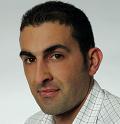By Sassoon Grigorian - armenia.com.au | Friday, 22 January 2010
 I still remember shaking Dink's hand in his Istanbul office, never imagining three years later a 100,000 strong funeral procession condemning his assassination chanting "We are all Hrant Dink: We are all Armenian"
I still remember shaking Dink's hand in his Istanbul office, never imagining three years later a 100,000 strong funeral procession condemning his assassination chanting "We are all Hrant Dink: We are all Armenian"
It is three years (January 19, 2007) since the assassination of Hrant Dink, an editor-in-chief of the bi-lingual Turkish Armenian newspaper Agos, and prominent member of the Armenian minority in Turkey. Dink for decades advocated for reconciliation between Turks and Armenians as well as calling on the Turkish Government to recognise the Armenian genocide, which took place in 1915.
Since Dink's assassination, significant progress has been made for reconciliation, however his loss emphasises the need for a unifying figure between Turks and Armenians. Despite progress, deep divisions exist, and the absence of an individual that can unify both peoples.
Dink was a unifying figure for many Armenians and those Turks advocating for democracy and free speech in Turkey and repealing repressing laws such as Article 301. Article 301 is a controversial article of the Turkish penal code making it illegal to insult Turkey, the Turkish ethnicity, or government institutions. Among those charged by Article 301 included Dink himself and Orhan Pamuk, Turkish writer and recipient of the Nobel Prize in Literature in 2006. Pamuk was charged following comments made in an interview about the mass killings of Kurds and Armenians in the Ottoman Empire.
There are those that argued Dink provoked Turkish nationalism. Soon after Dink's death, photographs of the assassin emerged flanked by smiling Turkish police, posing with the killer side by side in front of the Turkish flag. The photos created a scandal in Turkey.
Despite the scandal that ensued, there has been steady progress for reconciliation including the signing of an internet petition by some 200 Turkish intellectuals about the genocide, saying that they are sorry. The text of their apology did not use the term genocide, however around 30,000 Turks, from many different walks of life, signed the petition.
Then there was the bold move of football diplomacy last year where Armenia's President Serg Sargsyan invited Turkish President Abdullah Gul to Armenia's capital, Yerevan to watch the football World Cup qualifier between both countries. The invitation was reciprocated when the sides played in Turkey.
Finally, what was meant to be the momentous signing of Protocols between Turkey and Armenia last year degenerated into a political sideshow. The protocols have been formulated to restore diplomatic relations between both countries, however they are yet to be ratified by their respective Parliaments. The protocols have faced significant resistance within Turkey and Armenia because of the ambiguous language contained in the document, as well as the lack of consultation leading to the signing.
In all of this, one thing is clear, there is no individual or leader that stands out like Dink.
In a speech delivered in May 2006, at a seminar by the Turkish Journalists' Association and the Konrad Adenauer Foundation, Dink said "I think the fundamental problems in Turkey exist for the majority as well. Therefore, ... I will speak for the majority, including myself in it and dwell on where, we, as Turkey, are headed."
Well, the majority of people want a restoration of diplomatic relations between Turkey and Armenia, but there exists many different paths to getting there and continuing deep distrust. Dink had an ability to bring people together to a common ground. That is what is needed now.
Former President of South Africa, Nelson Mandela once said: "If you talk to a man in a language he understands, that goes to his head. If you talk to him in his language, that goes to his heart."
Dink spoke the language that went to the heart. He remains missed.
Sassoon Grigorian travelled to Turkey in 2004
comments
Կոչ Հայութեան ու Հայրենիքի Իշխանութեան
Editorial:1918-2024. The Struggle for Independent, Sovereign Statehood Continues
Armenia Media Updates: 29 March 2023 Edition
Armenia Media Updates: 23 March 2023 Edition
#TogetherForSyria Telethon Raises over $110,000 for Armenians In Syria
10 August 2022: Week to Week by Armenia Media with Shahen Araboghlian
3 July 2022: Week to Week by Armenia Media with Shahen Araboghlian
17 June 2022: Week to Week by Armenia Media with Shahen Araboghlian